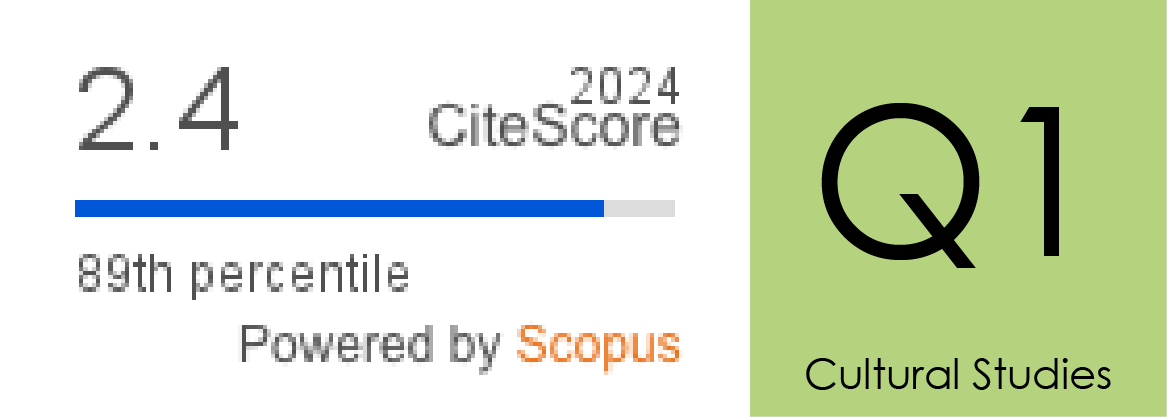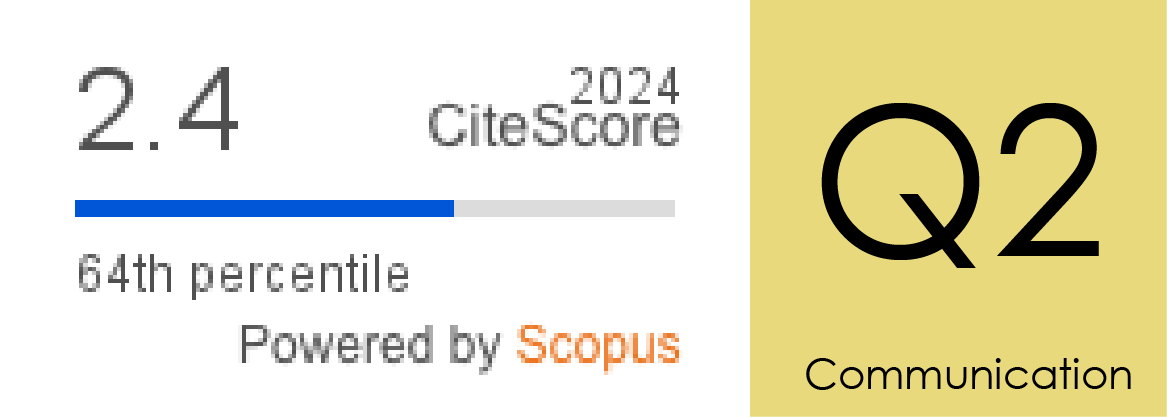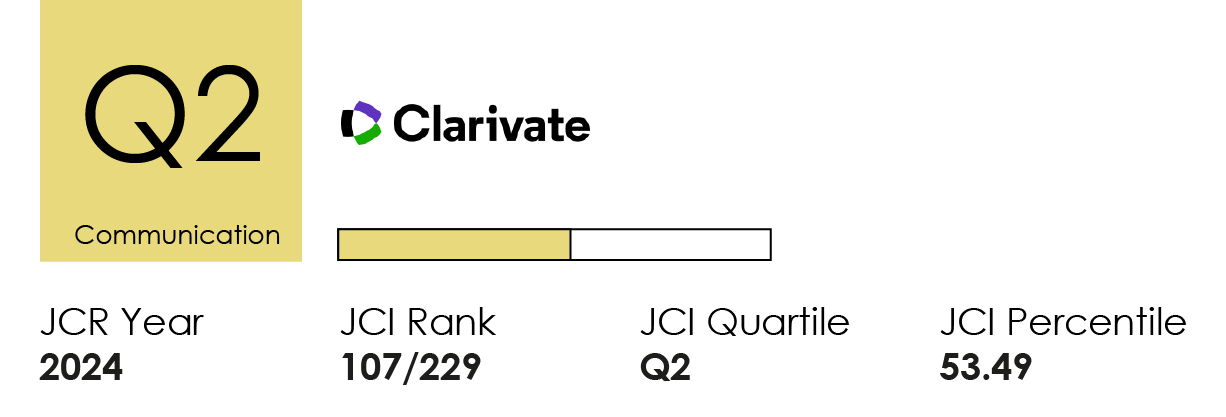Danza contemporánea y sincronía musicovisual en el videoclip musical actual
DOI:
https://doi.org/10.14198/MEDCOM2018.9.2.3Palabras clave:
Videoclip musical, danza contemporánea, sincronía, relación musicovisual, danza en audiovisualResumen
El video musical se ha convertido en un catalizador en la escena audiovisual actual, lo que permite localizar tendencias como centro de hibridación entre medios y lenguajes como la música y la danza. Ello le permite generar mensajes emocionalmente significativos para los espectadores. La danza contemporánea ofrece un tipo de performance o puesta en escena especialmente empleada en el videoclip en los últimos años. En el texto se realiza un análisis exploratorio de una muestra de videoclips donde la danza contemporánea es la protagonista y se relacionan con formas de sincronía musicovisual. Se establecen una serie de criterios de análisis aplicables a una muestra intencional y se propone una clasificación en relación al tipo de sincronía que forma. Las resultados permiten diferenciar tres tipos de videoclip según el uso de la danza. Las conclusiones apuntan que este tipo de videoclip prefiere la sincronía kinética y una tipología performance o performance/conceptual, entre otras soluciones visuales.
Citas
Auslander, P. (2008). Liveness: performance in a Mediatized culture. London: Editorial Routlege.
Auslander, P. (2011). Afterword: Is there Life after liveness? En Broadhurst, S. T & Machon, J. (Eds.), Performance and Tecnology: practices of virtual embodiment and Interactivity (pp. 194-198). London: Palgrave McMillan. https://doi.org/10.1007/978-0-230-28815-7_15
Bayston, M. (1987). Dancers on Television. Dancing Times, 77, 921-707. Disponible en https://goo.gl/3zpfaV
Bayston, M. (1992). Dancers on Television. Dancing Times, 82, 982-950. https://goo.gl/3zpfaV
Blanco Borelli, M. (2012). Dancing in Music Videos, or How I Learned to Dance Like Jane... Miss Jackson. The International Journal of Screendance. 2, 52-55. Disponible en https://goo.gl/QC5sxj
Bozzini, A. (1991). They Film as they Dance. Ballett International, 14(1), 37.
Buckland, T. (1998). Dance and Music Video: Some preliminary observations. En Carter, A. (Ed.), Routledge Dance Studies Reader (pp. 278-287). London, GBR: Routledge.
Chion, M. (1993). La audiovisión. Barcelona: Paidos.
Damasio, A. (2007). El error de Descartes [3ª Ed.]. Barcelona: Dakrontos Bolsillo.
Dodds, S. (2004). Dance on Screen: Genres and Media from Hollywood to Experimental Art. Nueva York: Palgrave. https://doi.org/10.1057/9780230509580
Frith, S. (1988). Music for Pleasure: Essays in the Sociology of Pop. Cambridge: Polity.
Gallesse, V.; Fadiga, L.; Fogassi, L. & Rizzolatti, G. (1996). Action recognition in the premotor cortex. Brain, 119(2), 593-609. https://doi.org/10.1093/brain/119.2.593
Gallese, V. (2001). The shared manifold hypothesis. Journal of Consciousness Studies, 8(5-7), 33–50. Disponible en https://goo.gl/JzwAoZ
Goodwin, A. (1992). Dancing in the distraction factory: Music television and popular culture. Minneapolis: Editorial University of Minnesota Press.
Gorbman, C. (2013). Unruly Media: YouTube, Music Video and the New Digital Cinema. Oxford: Oxford University Press.
Hagerdoorn, I. (2010). Dance, language and the brain. International Journal Arts and Technology, 2/3, 221-234.
Holt, F. (2011). Is music becoming more visual? Online video content in music industry. Visual Studies, 26(1) 50-61. https://doi.org/10.1080/1472586X.2011.548489
Jones, A. (1997). Presence’ in Absentia: Experiencing Performance as Documentation. Art Journal, 56(4), 11–18. https://doi.org/10.1080/00043249.1997.10791844
Jordan, S. (1992). Dance Screen 1992, Dancing Times, 82(984), 1154–1155. Disponible en https://goo.gl/3zpfaV
Korsgaard, M. (2012). Creation and Erasure: Music Video as a Signaletic Form of Practice. Journal of Aesthetics & Culture, 4(1). https://doi.org/10.3402/jac.v4i0.18151
Liu, C. (2014). Denaturalizaing Coco´s "Sexy" Hips: Contradictions and reversals of the dancing body of a chinese american superstar in Mandarin Pop. In Blanco Borelli, M. (Ed.), The Oxford Handbook of Dance and Popular Screen (pp. 268-288). Nueva York: Oxford University Press.
Maletic, V. (1987). Videodance: Technology: Attitude Shift. Dance Research Journal, 19(2), 3–7. https://doi.org/10.2307/1478165
Meisner, N. (1993). Aspiration and Aberration. Dance and Dancers, 515, 12–14.
Neuendorf, K. A. (2002). The content analysis guidebook. Thousand Oaks, California: Sage.
Nur Amin, T. (2014). Film Power, Real Politics: Dis/respectability, Post-raciality, and the politics of inclusion. In Blanco Borelli, M. (Ed.), The Oxford Handbook of Dance and Popular Screen. (pp. 255-267). Nueva York: Oxford University Press.
Parviainen, J. (2002). Bodily Knowledge: Epistemological Reflections on Dance. Dance Research Journal, 34(1), 11-22. https://doi.org/10.2307/1478130
Pavis, P. (2000). El análisis de los espectáculos: teatro, mimo, danza y cine. Barcelona: Paidós.
Peverini, P. (2010). The Aesthetics of Music Videos: An Open Debate. In Keazor, H. & Wübbena, T. (Eds.), Rewind, Play, Fast Forward. The Past, Present and Future of the Music Video (pp. 135-153). Bielefeld: transcript.
Ramachandran, V. S. (2007). Espejos en la mente, la ciencia de lo que nos hace humanos y creativos. Madrid: Debate.
Real Academia Española (2003). Diccionario de la Real Academia. Disponible en https://goo.gl/ODAJx
Rizzolatti, G.; Fogassi, L. & Gallese, V. (2001). Neurophysiological mechanisms underlying the understanding and imitation of action. Nature Reviews Neuroscience, (2), 661–670. https://doi.org/10.1038/35090060
Rizzolatti, G. & Craighero, L. (2007). Language and mirror neurons. In Gaskell, G. (Ed.), Oxford Handbook of Psycholinguistics (pp. 771-785). Oxford, UK: Oxford University Press. https://doi.org/10.1093/oxfordhb/9780198568971.013.0047
Rodríguez, M. A. (1997). El sonido en el lenguaje audiovisual. Barcelona: Paidós.
Rosiny, C. (2012). Video and its Narcissistic Potential in Dance: Four Examples in Video Art and Experimental Film, Stage Dance, and Screendance. The international Journal of screendance, (2), 68-70.
Sedeño, A. (2002). Lenguaje del videoclip. Málaga: Servicio de Publicaciones de la Universidad de Málaga.
Simeon, E. (1992). Programmi narrative e stratificazioni del senso nella musica per film. Il caso di Entracte. En Dalmonte, R. & Baroni, M. (Eds.), Atti di Secondo Convegno Europeo di Analisi Musicale (pp. 389-299). Trento: Universita degli Studi di Trento.
Thomas, P. (2014). Single Ladies, Plural: Racism, Scandal, and "Authenticity" within the Multiplication and Circulation of Online Dance Discourses. In Blanco Borelli, M (Ed.), The Oxford Handbook of Dance and Popular Screen (pp. 289- 303). Nueva York: Oxford University Press.
Vernallis, C. (2004). Experiencing music video: Aesthetic and cultural context. New York: Columbia University Press.
Viñuela Suárez, E. (2009.) El videoclip en España (1980-1995). Gesto audiovisual, discurso y mercado. Madrid: Ediciones del ICCMU.
Wells, A. (1990). Popular Music: Emotional Use and Management. The Journal of Popular Culture, 24(1), 105-117. https://doi.org/10.1111/j.0022-3840.1990.00105.x
Descargas
Estadísticas
Publicado
Cómo citar
Número
Sección
Licencia
Derechos de autor 2018 Virginia Guarinos-Galán, Ana Sedeño-Valdellós

Esta obra está bajo una licencia internacional Creative Commons Atribución-CompartirIgual 4.0.
Los autores y autoras que publican en esta revista están de acuerdo con los siguientes términos:
1 Derechos de autor. Los autores y autoras conservan sus derechos de autor, aunque ceden a la revista de forma no exclusiva los derechos de explotación (reproducción, distribución, comunicación pública y transformación) y garantizan a esta el derecho de primera publicación de su trabajo, el cual estará simultáneamente sujeto a la licencia indicada en punto 2. Los autores pueden establecer otros acuerdos adicionales para la distribución no exclusiva de la versión de la obra publicada en la revista, siempre que exista un reconocimiento de su publicación inicial en esta revista.
© Los autores.
2 Licencia. Los trabajos se publican en la revista sujetos a la licencia de Reconocimiento 4.0 Internacional de Creative Commons (CC BY 4.0); los términos se pueden consultar en https://creativecommons.org/licenses/by/4.0/
Esta licencia permite a terceros compartir (copiar y redistribuir el material en cualquier medio o formato) y adaptar (remezclar, transformar y crear a partir del material para cualquier finalidad, incluso comercial), siempre que se reconozca la autoría y la primera publicación en esta revista (Revista Mediterránea de Comunicación (RMC) / Mediterranean Journal of Communication (MJC), Universidad de Alicante, DOI de la obra), se proporcione un enlace a la licencia y se indique si se han realizado cambios en la obra.
3 Política de autoarchivo. Se recomienda a los autores que difundan sus trabajos a través de Internet para favorecer una circulación y difusión más rápidas y, con ello, un posible aumento en la citación y alcance entre la comunidad científica y académica, en las siguientes condiciones:
No se permite a los autores depositar en un repositorio institucional o temático, página web propia, etc., las versiones preprint (versión antes de ser evaluada) o postprint (versión evaluada y aceptada para su publicación) de sus trabajos antes de su publicación, pero sí el artículo final publicado (versión del editor).













